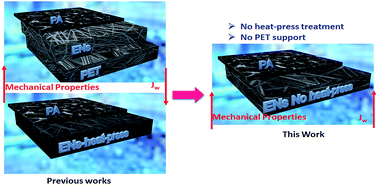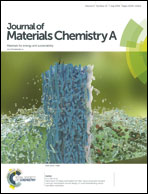Fabrication of highly permeable thin-film nanocomposite forward osmosis membranes via the design of novel freestanding robust nanofiber substrates†
Abstract
Although forward osmosis (FO) technology is considered to be a sustainable solution for the water and energy shortage, it has not been commercialized yet due to a few factors. Internal concentration polarization (ICP) is one of the most important barriers preventing the commercialization of the technology. To overcome the ICP obstacle, novel high-performance thin-film nanocomposite (TFN) membranes were successfully fabricated via interfacial polymerization on robust freestanding graphene oxide (GO) incorporated polyvinylidene fluoride (PVDF) nanofiber substrates. Compared to the pristine PVDF nanofiber substrate, the incorporation of GO (ranging from 0.1–15 wt%) significantly alters the chemical structure, porosity, wettability, morphology, and mechanical properties of the substrate, leading to an enhancement in the TFN membrane performance. The results showed that TFN5 (containing 5% GO) membrane possesses the lowest structural parameter of 85.5 μm (one of the best values in the literature), indicating a low internal concentration polarization (ICP) effect, resulting in a remarkably heightened water permeability (A; 2.96 L m−2 h−1 bar−1, enhanced by 167% compared to TFC). As a result, the membrane achieved the highest FO water flux at all draw solution concentrations (0.5–2 M NaCl), and the maximum FO water flux was 80.9 L m−2 h−1 (LMH) with a comparable specific salt flux (Js/Jv) of 0.41 g L−1 in the active layer facing the deionized feed water (AL-FS) when 2 M NaCl was applied as a draw solution. Interestingly, TFN5 was found to be the strongest material, with outstanding flexibility and strength over that of the TFC membrane. Furthermore, it showed high stability and durability during long-term FO operation. More importantly, the interaction mechanism between PVDF and GO was proposed schematically. Overall, the obtained results show highly efficient and promising TFN membranes that may overcome the drawbacks of the aforementioned FO membranes.



 Please wait while we load your content...
Please wait while we load your content...